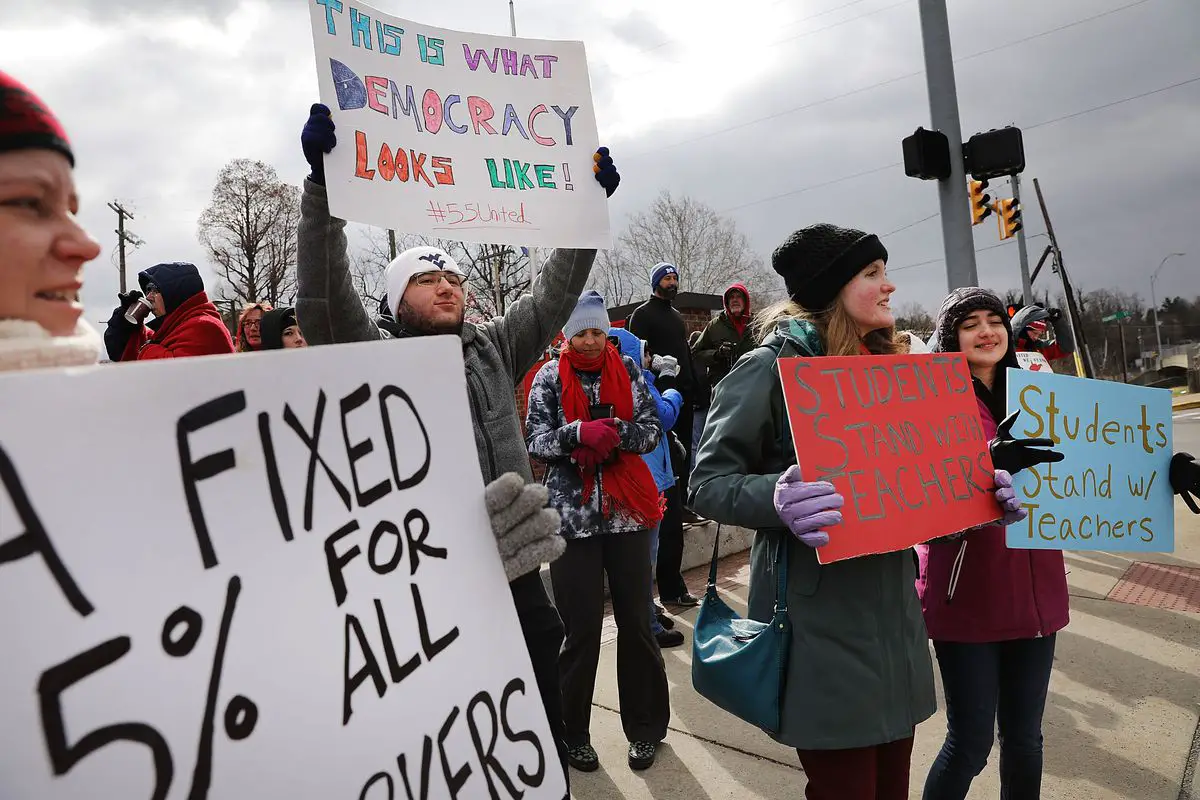This past Tuesday, West Virginia state legislators approved a 5 percent pay raise for teachers and other state employees. The deal effectively ended a nine-day teachers’ strike, which shut down public schools across the state.
The success of the West Virginia strikes has inspired teachers in other states, including Oklahoma and Arizona, to do the same. It has also focused national attention on the structural problems teachers face, problems that have no easy answers.
Tuesday’s deal included measures to answer the issue of low pay, one of the teachers’ primary concerns. Another essential concern, that of rising health care costs, went unanswered.
During the strike, the Public Employees Insurance Agency (PEIA), the state agency responsible for providing teachers and other public employees with insurance, committed to freezing rates in 2019, while West Virginia governor Jim Justice announced a task force that will meet to research possible means of fixing structural issues with insurance.
Neither of these measures offers any certainty of a long-term solution, and teachers are worried that nothing will end up changing.
In the words of West Virginia English teacher Erica Newsome, “We are underpaid and we do need a raise, but if we aren’t going to fix the insurance, it’s just the same story as before.”
This story is one of low funding and harsh belt-tightening. For the past few years, PEIA has been increasing premiums and reducing benefits as health care costs have gone up and state funding has remained stagnant. According to analyst and activist Cathy Kunkel, “For the average teacher, premiums have risen $348 a year, deductibles by $400, and the out of pocket maximum by $2,000.”
The 2019 freeze in rates, adopted as a concession to teachers during the strike, has blown an even bigger hole in the budget, which state legislators are scrambling to fill. Despite its impact on the budget, teachers, who are still struggling to come to terms with the previous few years of rate hikes, consider the current freeze barely enough.
No cohesive long-term plans for fully funding PEIA have been proposed as of yet, although several suggestions were considered during the teachers strike. Even if legislators are able to figure out the funding situation for PEIA, larger concerns will remain around education funding.
West Virginia schools have faced extensive shortages in funding over the past few years. In 2016, $11.1 million was cut from the public school system, despite the financial difficulties and deficits faced by multiple school districts.
Matters have not improved since then, with the 2017 budget including $16 million in cuts to higher education and $5 million to K-12 education programs.
Shortages in funding have led to a shortage of teachers, as neighboring states lure away West Virginia teachers with higher pay and greater benefits. Rather than finding the money to make up these shortages, the state legislature has resorted to hiring teachers who are less qualified, and so less expensive.
According to the West Virginia Department of Education, a significant number of courses are already taught by teachers who are not fully certified to teach those subjects — for instance, 38 percent of math courses in public secondary schools are taught by teachers who do not have the proper certifications.
A recent bill proposed to loosen the requirements of an alternate certification, allowing people to teach subjects with which they have had no prior academic or occupational experience.
Funding shortages have also led to decreased school resources and programs. Teachers have stepped up to fill the gaps, at great personal cost. “Generally, in a year, I probably pay anywhere from $1,000 to $1,500 out of my own paycheck, and those are just for miscellaneous supplies,” said kindergarten teacher Cindy Nester.
The financial outlook is much the same for educational systems across the country: stagnating salaries, decreased funding and rising health care costs. In many states, after adjusting for inflation, salaries have shrunk over the past few years.
This situation has led to teacher shortages across the country, with all 50 states starting the year with fewer teachers available than required.
The West Virginia strikes have helped bring these issues to national prominence. They have also inspired educators in other states to follow suit, facing similar issues and emboldened by the fellow teachers’ success.
Oklahoma is one of the states in which teachers are contemplating action. Oklahoma teachers are currently the lowest paid in the nation — many are paid significantly less than gas station employees. In the wake of the West Virginia strikes, Oklahoma teacher unions have declared an ultimatum; teachers will strike on April 2 unless sufficient raises in pay have been made.
Arizona hasn’t committed to action in the same way, but it is considering following in the footsteps of West Virginia and Oklahoma. Similarly to West Virginia, Arizona teachers are increasingly underqualified, a situation resulting from low pay and slashed educational funding.
This past Wednesday, teachers across the state wore red to protest their lack of resources, referencing the red worn in the West Virginia strikes. While there are no concrete plans for a strike as of yet, support for some kind of action is high among teachers.
The nationwide outlook for teachers is grim. Education funding is being cut across the board, health care costs are rising and teachers’ salaries are stagnating or falling. Despite the situation, there is some good news mixed up with the bad.
Though it may not have been enough to fix the health insurance issues or reverse nationwide trends, the West Virginia strikes ended with teachers getting a raise.
In addition, students and teachers stood together throughout the West Virginia strikes, assisting each other as best they could. Students have been generally supportive of the strike, some even picketing alongside their teachers. Meanwhile, teachers have delivered food to students who relied on school breakfast and lunch.
The relationship between students and teachers, the essence of teaching, has stayed strong, even in the communities with the greatest financial difficulties. Though the debate still rages over education funding and health care costs, this is one constant that bodes well for the future.

















